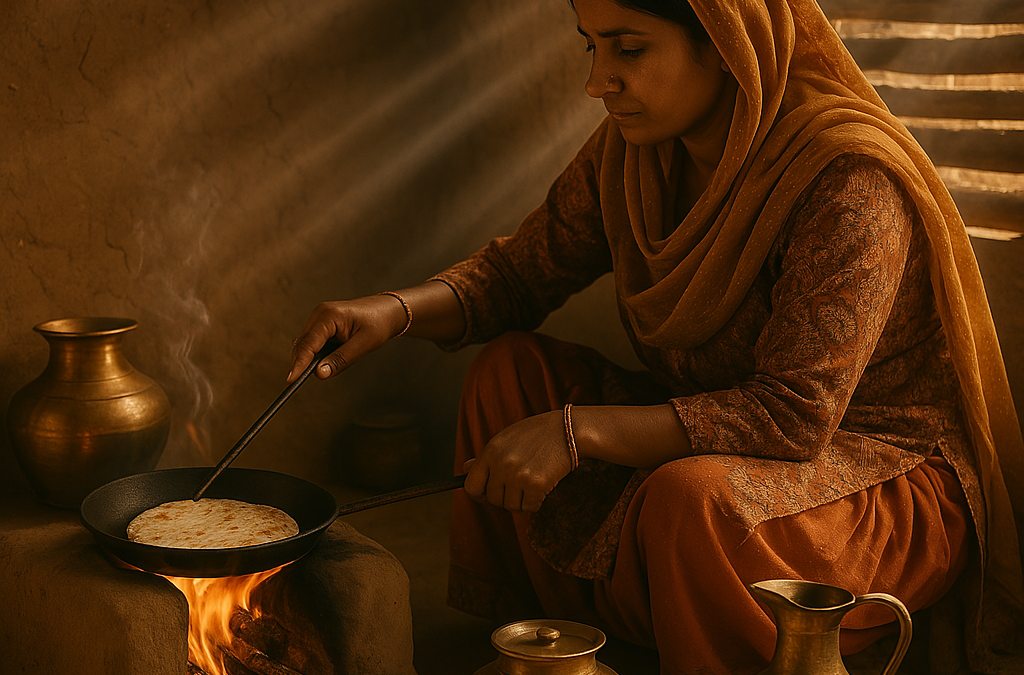The Soil Where It All Began
Before it became a global food phenomenon, Punjabi cuisine was the language of the land, spoken through wheat fields, rivers, clay pots, and open fires. Punjab, the land of five rivers, has been among the most fertile plains in India, and its cuisine is deeply rooted in the agrarian lifestyle. Wheat was not just a crop—it was a way of life. The chulha (mud stove) fired with cow dung cakes, the smoke-infused rotis, and the daily churn of buttermilk defined nourishment.
Milk came straight from the cattle in the courtyard. Ghee was made in-house. Seasonal vegetables and pulses, stored in tall brass containers, rotated with the weather. This was not slow food by design; it was simply how food happened—seasonal, local, and rich in nutrients and soul.
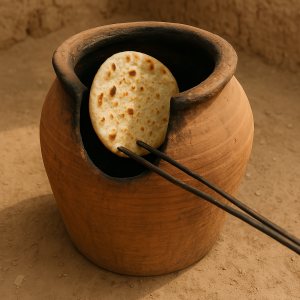
Tandoori Rotis in the Making: Traditional whole wheat rotis puff to perfection inside a clay tandoor—bringing the rustic warmth of Punjabi kitchens alive.
A Tapestry Woven with Invasions and Influence
Over the centuries, Punjab has been the crossroads of civilisations. Greek, Persian, Central Asian, and Mughal influences came not just with soldiers but with masalas, techniques, and tastes. Each wave left something behind—a spice, a method, an indulgence.
The Mughals brought with them the luxury of dry fruits, saffron, and charcoal-based cooking. Though biryani is not traditionally Punjabi, it inspired the pulao with caramelised onions and whole spices. Tandoori cooking, now a culinary ambassador of Punjab, was once a Persian technique refined in the villages of the North.
The real Punjabi genius lay in embracing the best and then making it their own. They took the finesse of Mughal gravies and gave it the earthiness of homegrown ingredients. They married opulence with humility.
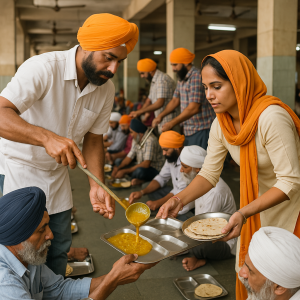
Langar Hall: A sacred space of equality and nourishment, where humble hands serve food cooked with devotion and hearts are fed along with stomachs.
The Langar Revolution – Food with Faith
To understand Punjabi food without understanding langar is to miss the soul of the cuisine. Every Sikh gurdwara, whether small or monumental, serves langar—free food to anyone who walks in, regardless of caste, creed, religion, or economic status.
This practice started with Guru Nanak in the 15th century and continues with unbroken fervour. The meal is simple—dal, roti, sabzi, and kheer—but cooked in massive quantities by volunteers and served with deep humility. It is food stripped of ego, imbued with devotion.
It’s also a reminder that food, in Punjab, is a binding force—across tables, communities, and beliefs.
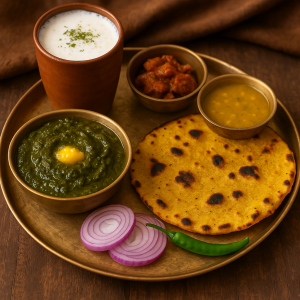
Makki di Roti and Sarson da Saag: The soul of a Punjabi winter, served with homemade lassi, white butter, and the warmth of tradition.
A Plateful of Seasons: The Natural Calendar
Punjabi food changes with the weather. In winter, sarson da saag and makki di roti are not just traditional—they are necessary. Mustard greens and maize are winter crops. They heat the body and offer energy. A generous dollop of homemade white butter is not a garnish; it’s winter insulation.
Summers are for lassi, kadhi, and phulkas with tori (ridge gourd) or karela (bitter gourd). Pickles bubble under the sun in ceramic jars. Lentils like moong and masoor take centre stage.
Festivals bring their menus—pinni during Lohri, besan barfi during Diwali, and seviyan for Eid. In every phase of the year, Punjabi food adapts, absorbs, and celebrates.
The Global Leap: When Punjab Travelled Abroad
The great Punjabi migration—during Partition, and later in the search for opportunity—carried its food across oceans. From Canada to Kenya, and from Birmingham to Brisbane, Punjabi kitchens sprouted and blossomed.
Butter chicken and dal makhani made their way onto global menus. But more importantly, the diaspora kept food traditions alive. Homemade spice mixes, pickles sent in aluminium foil, recipes shared on international calls, and tiffins layered with memory and masala—these became the new age vessels of heritage.
Indian restaurants abroad, often run by Punjabi families, became gateways to the larger Indian cuisine. And just like back home, Punjabi food wore its boldness with pride.
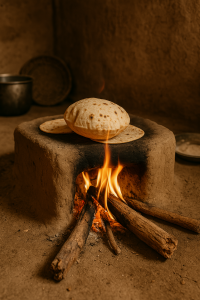
The Soul of the Village Kitchen: A traditional Punjabi clay chulha breathes life into every meal with its earthy heat and slow-cooked magic
Wellness Meets Tradition: The Modern Remix
In the age of calorie counting, Punjabi food gets a bad rap for being heavy. But scratch beneath the cream and you’ll find a system rooted in balance. Most dishes, even indulgent ones, can be made lighter without losing flavour.
Whole wheat instead of refined flour, air frying instead of deep frying, and ghee in measured spoons—these changes are already making their way into urban kitchens.
Meanwhile, traditional techniques like slow cooking, fermentation (think kadhi and dahi), and seasonal eating are exactly what modern nutritionists recommend. Punjabi food never forgot them. It simply served them with extra butter.
The Road Ahead: Innovation Without Erasure
Today, Punjabi cuisine stands at a delicious crossroad. Food festivals, Instagram reels, fusion pop-ups, and cooking shows are celebrating its charm. Butter chicken tacos, makki di roti quesadillas, and saag risotto are not blasphemy—they’re dialogue.
But innovation must walk hand-in-hand with preservation. If we remix without reverence, we lose the poetry behind the plate.
Our great-grandmothers stirred brass pots with wooden ladles, tasting not just for salt but for emotion. That instinct, that artistry, must never be lost.
Final Thoughts
Punjabi food is not just about flavours — it’s a way of life. The smell of wood smoke, the feel of fresh dough in your hands, the slow bubbling of rich gravies, and the joy of sharing meals with loved ones — this is what makes it special.
Eating Punjabi food means being part of a story that started on simple farms and now travels far and wide, carried in copper pots and family memories.
May this tradition continue to warm hearts and homes for generations to come.
We’d love to hear from you!
Have you tried any Punjabi dishes that hold a special place in your heart? Share your stories and favourite recipes in the comments below. If this article brought back memories or inspired you to cook, please like and share it with your family and friends. For more recipes and stories, follow us on Facebook — let’s keep the love for Punjabi food alive together!

